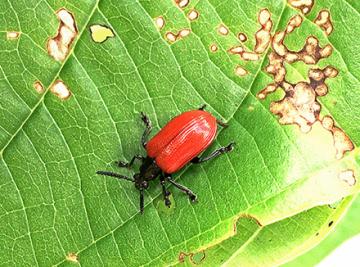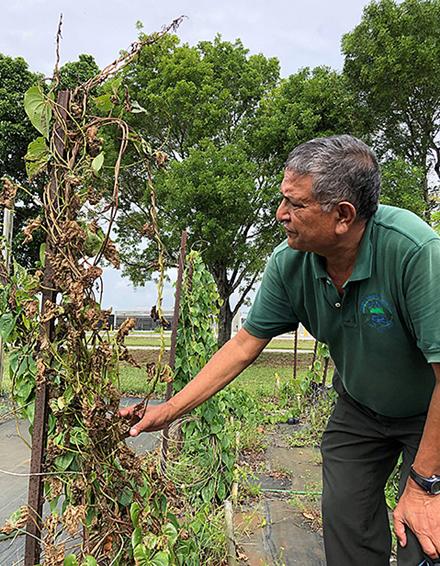Science and Serendipity Defeat Invasion of the Air Potato

The air potato beetle, Lilioceris cheni, is a biological control agent of the air potato vine, Dioscorea bulbifera, one of the most aggressive invasive weeds in the southeastern United States. (Dale Halbritter, D4349-1)
The plot could have come from Hollywood — an insidious alien invader threatens to overrun the land, but intrepid scientists discover a secret weapon in the far-off, exotic land of Nepal and bring the pestilence to heel. But this is not fiction; it’s true.
The air potato plant (Dioscorea bulbifera) is an exotic vine from Asia that was introduced to Florida about 115 years ago to make medicine. After escaping from the lab, it multiplied and smothered native plant communities in all of Florida’s 67 counties. It spread beyond to large swaths of land in the southeastern United States. The weed got its name from the potato-like “aerial bulbils” it produces. While the bulbils do not produce seeds, they do sprout new vines.
All attempts to manage the air potato – mechanical, chemical, or physically gathering the bulbils — were unsuccessful; they were either too labor intensive and costly or caused collateral damage to native and endangered species. According to Min Rayamajhi, a plant pathologist at the Agricultural Research Service’s (ARS) Invasive Plant Research Laboratory (IPRL) in Fort Lauderdale, FL, the vines return every season, repeating the growth cycle and expanding the invasion at a rate of about 6 inches per day.
Rayamajhi and retired ARS scientist Bob Pemberton traveled to Nepal and accidentally discovered the air potato beetle. The pair had been in Nepal to survey natural enemies of other weeds when they unexpectedly ran into the air potato beetle, an insect that feeds on air potato leaves. The beetles (Lilioceris cheni), red from Nepal and orange from China, are rather large, nearly one-half inch long.
The scientists brought the beetles back to Florida, where Pemberton tested the beetles for host specificity during a 5-year period in the IPRL quarantine facility. The beetles had opportunities to feed on plants of economic and ecological importance, but were found to be highly host-specific, meaning they feed and multiply only on foliage of the air potato vine. Based on these findings, USDA’s Animal and Plant Health Inspection Service issued a permit for release in the U.S.

ARS plant pathologist Min Rayamajhi examines air potato vines, Dioscorea bulbifera, damaged by adult and larval individuals of air potato beetle, Lilioceris cheni, at the outdoor nursery of the Invasive Plant Research Laboratory in Fort Lauderdale, FL. (Jenna Owens, D4401-1)
Rayamajhi developed a multi-agency collaborative mass release and research project that evaluated beetle-mediated impact on the air potato populations in Florida. The program ultimately resulted in the release of over a million beetles at approximately 4,000 locations in Florida, southern Georgia, Louisiana, Alabama, and part of Texas. The air potato beetle larvae and adults devoured up to 70 percent of air potato foliage, which led to a 90 percent reduction of vine cover on native plant communities, 90 percent of aerial bulbils, and biomass by 95 percent.
Surveys conducted in 2015 and 2019 showed that the beetles were firmly established in their new domains. “The beetles have successfully overwintered and emerged every year after the air potato vines grew back,” Rayamajhi said.
“Our research objective was to saturate invasive plant communities,” he said. “We accomplished that in a relatively short period – 7 years, compared to other projects that may take decades.”
Weeds are never completely eradicated, so odds are that the air potato is here to stay. However, according to IPLR officials, so long as the self-sustaining beetles are on the job, the air potato invasion is under control. “Our lab will continue to gather data to fill in the research gaps on this biocontrol project,” Rayamajhi said, “but mass production and release of air potato beetles at IPRL have ceased; our resources are now mobilized to meet the challenges of controlling other invasive plants.” – By Scott Elliott, ARS Office of Communications.

